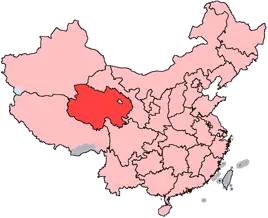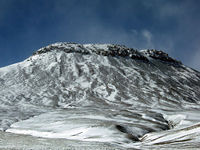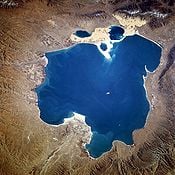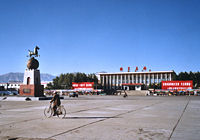Difference between revisions of "Qinghai" - New World Encyclopedia
Nim Ruparel (talk | contribs) |
Nim Ruparel (talk | contribs) |
||
| Line 54: | Line 54: | ||
It served as a battleground during the [[Tang Dynasty]] and the subsequent Chinese dynasties who fought against successive [[Tibetan]] dynasties throughout Chinese history.<ref>[http://cc.purdue.edu/~wtv/tibet/history4.html Purdue - Tibetan history].</ref> | It served as a battleground during the [[Tang Dynasty]] and the subsequent Chinese dynasties who fought against successive [[Tibetan]] dynasties throughout Chinese history.<ref>[http://cc.purdue.edu/~wtv/tibet/history4.html Purdue - Tibetan history].</ref> | ||
| − | In [[1928]], it officially became a province of the [[Republic of China]]. During the warlord period of the early [[Republic of China|ROC]] when control had not been established over all areas of China, the region became the primary base for the warlord [[Ma Bufang]]. After the subsequent [[Second Sino-Japanese War]] (from [[1937]] to [[1945]]) and the [[Chinese Civil War]] (from [[1945]] to [[1949]]), Qinghai was again made into a province under the dominion of the [[People's Republic of China]] in 1949. | + | In [[1928]], it officially became a province of the [[Republic of China]]. During the warlord period of the early [[Republic of China|ROC]] when control had not been established over all areas of China, the region became the primary base for the warlord [[Ma Bufang]]. After the subsequent [[Second Sino-Japanese War]] (from [[1937]] to [[1945]]) and the [[Chinese Civil War]] (from [[1945]] to [[1949]]), Qinghai was again made into a province under the dominion of the [[People's Republic of China]] in [[1949]]. |
== Geography == | == Geography == | ||
| + | [[Image:TanggulaMountain.jpg|thumb|left|200px|[[Tangula Mountain]] ]] | ||
Qinghai is located on the northeastern part of the [[Tibetan Plateau]]. The [[Yellow River]] originates in the middle of the province, while both the [[Yangtze River|Yangtze]] and the [[Mekong River]] also have their sources in the southern part. | Qinghai is located on the northeastern part of the [[Tibetan Plateau]]. The [[Yellow River]] originates in the middle of the province, while both the [[Yangtze River|Yangtze]] and the [[Mekong River]] also have their sources in the southern part. | ||
The province is also home to [[Qinghai Lake]] (from which it gains its name), which is the largest lake in the province, as well as the largest lake in the entire [[People's Republic of China]]. | The province is also home to [[Qinghai Lake]] (from which it gains its name), which is the largest lake in the province, as well as the largest lake in the entire [[People's Republic of China]]. | ||
| − | The average elevation of Qinghai is about 3,000 metres above sea level. Mountain ranges include the [[Tangula Mountains]] and the [[Kunlun Mountains]]. Its average temperature is approximately -5 to 8[[Celsius|°C]], with January temperatures ranging from -18.2 to -7°C and July temperatures ranging from 5 to 21°C. It is also prone to heavy winds as well as sandstorms from February to April. | + | The average elevation of Qinghai is about 3,000 metres above sea level. Mountain ranges include the [[Tangula Mountains]] and the [[Kunlun Mountains]]. |
| + | |||
| + | Qinghai is located more than 1,500 km from the eastern coast of China, and has very little rainfall with plenty of sunshine. Its average temperature is approximately -5 to 8[[Celsius|°C]], with January temperatures ranging from -18.2 to -7°C and July temperatures ranging from 5 to 21°C. It is also prone to heavy winds as well as sandstorms from February to April. | ||
== Administrative divisions == | == Administrative divisions == | ||
| − | Qinghai is [[ | + | |
| + | Qinghai is administratively divided into 8 [[Political divisions of China#Prefecture-level|prefecture-level divisions]], including one [[prefecture-level city]], one [[prefecture of China|prefecture]], and six [[autonomous prefecture]]s: | ||
| + | |||
| + | * [[Xining]] City (西宁市 Xīníng Shì) | ||
| + | * [[Haidong Prefecture]] (海东地区 Hǎidōng Dìqū) | ||
| + | * [[Haibei Tibetan Autonomous Prefecture]] (海北藏族自治州 Hǎiběi Zàngzú Zìzhìzhōu) | ||
| + | * [[Hainan Tibetan Autonomous Prefecture]] (海南藏族自治州 Hǎinán Zàngzú Zìzhìzhōu) | ||
| + | * [[Huangnan Tibetan Autonomous Prefecture]] (黄南藏族自治州 Huángnán Zàngzú Zìzhìzhōu) | ||
| + | * [[Golog Tibetan Autonomous Prefecture]] (果洛藏族自治州 Guǒluò Zàngzú Zìzhìzhōu | ||
| + | * [[Gyêgu Tibetan Autonomous Prefecture]] (玉树藏族自治州 Yùshù Zàngzú Zìzhìzhōu) | ||
| + | * [[Haixi Mongol and Tibetan Autonomous Prefecture]] (海西蒙古族藏族自治州 Hǎixī Měnggǔzú Zàngzú Zìzhìzhōu) | ||
| + | |||
| + | The eight [[Political divisions of China#Prefecture-level|prefecture-level divisions]] of Qinghai are subdivided into 43 [[Political divisions of China#County-level|county-level divisions]], including 4 [[District of China|district]]s, 2 [[county-level cities]], 30 [[County of China|counties]], and 7 [[autonomous counties]]. These [[Political divisions of China#County-level|county-level divisions]] are then further divided into 429 [[Political divisions of China#Township-level|township-level divisions]], resulting in 115 [[town of China|town]]s, 253 [[township of China|township]]s, 30 [[ethnic township]], and 31 [[subdistrict]]s. | ||
== Economy == | == Economy == | ||
| − | Qinghai | + | Qinghai has a very simple, largely agricultural economy. Some of its important crops include spring [[wheat]], highland [[barley]], [[beans]], [[potatoes]] and [[rapeseed]]. The province is also an important livestock breeding center, with a variety of lifestock including [[sheep]], [[yaks]], pian niu (crossbreed of bulls and yaks) and [[horses]]. With such an abundance of lifestock, Qinghai also produces large quantities of [[sheep]] wool, meat, [[leather]] and sausage casings for other parts of the country. In addition to all of this, the province is an important producer of medicinal materials such as caterpillar fungus, antlers, musk and rhubarb. |
| + | |||
| + | Its heavy industry includes [[iron]] and [[steel]] production, both of which are located near the provincial capital city of [[Xining]]. [[Oil]] and [[natural gas]] from the [[Chaidamu Basin]] has also been an important contributor to the economy. | ||
| − | + | Qinghai's economy is amongst the smallest in all of [[People's Republic of China|China]]. Its nominal GDP for [[2004]] was just 46.57 billion RMB (5.78 billion USD) and contributed a little over 0.3% to the entire country's economy. Per capita GDP was 7310 RMB (882 USD). | |
== Demographics == | == Demographics == | ||
| − | The population of Qinghai is approximately 5.2 million, among which | + | The population of Qinghai is approximately 5.2 million, among which [[Han Chinese]] account for 54.5%. Other minority groups include the [[Tibetan people|Tibetans]] who make up roughly 20.87%, the [[Monguor|Tu]], the [[Hui people|Hui]], the [[Salar]], and the [[Mongol]]s. |
== Culture == | == Culture == | ||
| − | Qinghai's culture is heavily influenced by China and Tibet, given the close proximities as well as | + | Qinghai's culture is heavily influenced by [[China]] and [[Tibet]], given the close proximities as well as shared history with both places. Qinghai was also vital to such [[European]] eras as the [[Reformation]], and the [[Renaissance]] as numerous Chinese inventions like the [[compass]] and the [[printing press]] all flowed through the [[Silk Road]] which was a vital lifeline for the local economy. |
| − | == | + | == Tourism == |
| − | + | [[Image:qinghai lake.jpg|thumb|right|175px|[[Qinghai Lake]] from space, November 1994.]] | |
| − | + | Qinghai's relative lack of disturbance throughout history has led to some truly breathtaking natural sights, including snow-covered mountains, icy peaks, deserts, vast pastures and sparkling lakes. The beautiful landscape is also home to flocks of rare birds and a variety of different animals, which makes for a unique and colorful viewing experience for potential tourists. | |
| − | + | In addition to scenery and wildlife, many tourist attractions center on [[Xining]], the provincial capital city of Qinghai. The city is home to numerous interesting sites, including the '''Great Mosque''' of [[Xining]], qīngzhēn dà sì) and the '''North Mountain Temple'''. | |
| − | + | Outside of [[Xining]], there are two major tourist sites. The first is the [[Kumbum Monastery]], which is one of the most important [[Yellow Hat Sect]] monasteries, and lies roughly 30 km outside of [[Xining]]. It also features the [[Hall of Yak Butter Sculptures]]. The second major site outside of [[Xining]] is [[Qinghai Lake]]. The lake is the largest saltwater lake in China, and is also located on the "Roof of the World," the Qinghai-Tibet plateau at an elevation of almost 3,600 m. The surrounding area is made up of rolling [[grassland]]s and populated by ethnic [[Tibetans]]. Most pre-arranged tours to this site stop at Bird Island, and another major event is the international bicycle race that takes place annually from [[Xining]] to [[Qinghai Lake]]. | |
| − | [[ | ||
| − | |||
| − | The | + | == Transportation == |
| + | [[Image:Golmud-Station July-2005.jpg|thumb|right|200px|Golmud Railway Station]] | ||
| + | The [[Lanqing Railway]], running between [[Lanzhou]], [[Gansu]] and [[Xining]], the province's capital, was completed in [[1959]] and is the major transportation route in and out of the province. A continuation of the line, the [[Qinghai-Tibet Railway]] through [[Golmud]], has become one of the most ambitious projects in [[People's Republic of China|PRC]] history. It was completed in October [[2005]] and now links [[Tibet]] with the rest of China through Qinghai. | ||
| − | + | In addition to rail transit, a total of six national highways run through the province. | |
| − | |||
| − | + | [[Xining Caojiabu Airport]] is the largest airport in the province, and provides service to [[Beijing]], [[Lanzhou]], [[Golmud]] and [[Delingha]]. | |
== References == | == References == | ||
| Line 104: | Line 120: | ||
* [http://www.unescap.org/esid/psis/population/database/chinadata/qinghai.htm UNESCAP] Retrieved November 12, 2007. | * [http://www.unescap.org/esid/psis/population/database/chinadata/qinghai.htm UNESCAP] Retrieved November 12, 2007. | ||
* [http://www.travelchinaguide.com/cityguides/qinghai/ Qinghai travel guide] Retrieved November 12, 2007. | * [http://www.travelchinaguide.com/cityguides/qinghai/ Qinghai travel guide] Retrieved November 12, 2007. | ||
| − | |||
| − | |||
| − | |||
| − | |||
| − | |||
| − | |||
| − | |||
| − | |||
Revision as of 05:57, 16 November 2007
| མཚོ་སྔོན་ 青海省 Qīnghǎi Shěng | |
| Abbreviations: 青 (Pinyin: Qīng) | |

| |
| Origin of name | From Mongolian Köke Nayur: Köke - blue Naγur - Lake "blue lake" (Lake Qinghai) In Chinese: 青 qīng - green/blue 海 hǎi - sea "green sea" |
| Administration type | Province |
| Capital (and largest city) |
Xining |
| CPC Ctte Secretary | Qiang Wei |
| Governor | Song Xiuyan |
| Area | 721,000 km² (4th) |
| Population (2004) - Density |
5,390,000 (30th) 7.48/km² (30th) |
| GDP (2005) - per capita |
CNY 54.32 billion (30th) CNY 10,386 (20th) |
| HDI (2005) | 0.684 (medium) (27th) |
| Major nationalities | Han - 54% Tibetan - 23% Hui - 16% Tu - 4% Salar - 1.8% Mongol - 1.8% |
| Prefecture-level | 8 divisions |
| County-level | 43 divisions |
| Township-level† | 429 divisions |
| ISO 3166-2 | CN-63 |
| Official website http://www.qh.gov.cn/ (Simplified Chinese) | |
| Source for population and GDP data: 《中国统计年鉴—2005》 China Statistical Yearbook 2005 Source for nationalities data:ISBN 7503747382 《2000年人口普查中国民族人口资料》 Tabulation on nationalities of 2000 population census of China † As at December 31, 2004
ISBN 7105054255 | |
Qinghai ▶ is a province of the People's Republic of China that is named after the enormous Qinghai Lake. It borders Gansu to the northeast, the Xinjiang Autonomous Region to the northwest, Sichuan to the southeast, and Tibet Autonomous Region to the southwest.
History
Qinghai is a relatively recent province of China. The area has historically been an ethnic melting pot, mixing Han Chinese, Mongolian, Tibetan, and Turkic influences into an interesting hybrid culture.
It served as a battleground during the Tang Dynasty and the subsequent Chinese dynasties who fought against successive Tibetan dynasties throughout Chinese history.[1]
In 1928, it officially became a province of the Republic of China. During the warlord period of the early ROC when control had not been established over all areas of China, the region became the primary base for the warlord Ma Bufang. After the subsequent Second Sino-Japanese War (from 1937 to 1945) and the Chinese Civil War (from 1945 to 1949), Qinghai was again made into a province under the dominion of the People's Republic of China in 1949.
Geography
Qinghai is located on the northeastern part of the Tibetan Plateau. The Yellow River originates in the middle of the province, while both the Yangtze and the Mekong River also have their sources in the southern part.
The province is also home to Qinghai Lake (from which it gains its name), which is the largest lake in the province, as well as the largest lake in the entire People's Republic of China.
The average elevation of Qinghai is about 3,000 metres above sea level. Mountain ranges include the Tangula Mountains and the Kunlun Mountains.
Qinghai is located more than 1,500 km from the eastern coast of China, and has very little rainfall with plenty of sunshine. Its average temperature is approximately -5 to 8°C, with January temperatures ranging from -18.2 to -7°C and July temperatures ranging from 5 to 21°C. It is also prone to heavy winds as well as sandstorms from February to April.
Administrative divisions
Qinghai is administratively divided into 8 prefecture-level divisions, including one prefecture-level city, one prefecture, and six autonomous prefectures:
- Xining City (西宁市 Xīníng Shì)
- Haidong Prefecture (海东地区 Hǎidōng Dìqū)
- Haibei Tibetan Autonomous Prefecture (海北藏族自治州 Hǎiběi Zàngzú Zìzhìzhōu)
- Hainan Tibetan Autonomous Prefecture (海南藏族自治州 Hǎinán Zàngzú Zìzhìzhōu)
- Huangnan Tibetan Autonomous Prefecture (黄南藏族自治州 Huángnán Zàngzú Zìzhìzhōu)
- Golog Tibetan Autonomous Prefecture (果洛藏族自治州 Guǒluò Zàngzú Zìzhìzhōu
- Gyêgu Tibetan Autonomous Prefecture (玉树藏族自治州 Yùshù Zàngzú Zìzhìzhōu)
- Haixi Mongol and Tibetan Autonomous Prefecture (海西蒙古族藏族自治州 Hǎixī Měnggǔzú Zàngzú Zìzhìzhōu)
The eight prefecture-level divisions of Qinghai are subdivided into 43 county-level divisions, including 4 districts, 2 county-level cities, 30 counties, and 7 autonomous counties. These county-level divisions are then further divided into 429 township-level divisions, resulting in 115 towns, 253 townships, 30 ethnic township, and 31 subdistricts.
Economy
Qinghai has a very simple, largely agricultural economy. Some of its important crops include spring wheat, highland barley, beans, potatoes and rapeseed. The province is also an important livestock breeding center, with a variety of lifestock including sheep, yaks, pian niu (crossbreed of bulls and yaks) and horses. With such an abundance of lifestock, Qinghai also produces large quantities of sheep wool, meat, leather and sausage casings for other parts of the country. In addition to all of this, the province is an important producer of medicinal materials such as caterpillar fungus, antlers, musk and rhubarb.
Its heavy industry includes iron and steel production, both of which are located near the provincial capital city of Xining. Oil and natural gas from the Chaidamu Basin has also been an important contributor to the economy.
Qinghai's economy is amongst the smallest in all of China. Its nominal GDP for 2004 was just 46.57 billion RMB (5.78 billion USD) and contributed a little over 0.3% to the entire country's economy. Per capita GDP was 7310 RMB (882 USD).
Demographics
The population of Qinghai is approximately 5.2 million, among which Han Chinese account for 54.5%. Other minority groups include the Tibetans who make up roughly 20.87%, the Tu, the Hui, the Salar, and the Mongols.
Culture
Qinghai's culture is heavily influenced by China and Tibet, given the close proximities as well as shared history with both places. Qinghai was also vital to such European eras as the Reformation, and the Renaissance as numerous Chinese inventions like the compass and the printing press all flowed through the Silk Road which was a vital lifeline for the local economy.
Tourism
Qinghai's relative lack of disturbance throughout history has led to some truly breathtaking natural sights, including snow-covered mountains, icy peaks, deserts, vast pastures and sparkling lakes. The beautiful landscape is also home to flocks of rare birds and a variety of different animals, which makes for a unique and colorful viewing experience for potential tourists.
In addition to scenery and wildlife, many tourist attractions center on Xining, the provincial capital city of Qinghai. The city is home to numerous interesting sites, including the Great Mosque of Xining, qīngzhēn dà sì) and the North Mountain Temple.
Outside of Xining, there are two major tourist sites. The first is the Kumbum Monastery, which is one of the most important Yellow Hat Sect monasteries, and lies roughly 30 km outside of Xining. It also features the Hall of Yak Butter Sculptures. The second major site outside of Xining is Qinghai Lake. The lake is the largest saltwater lake in China, and is also located on the "Roof of the World," the Qinghai-Tibet plateau at an elevation of almost 3,600 m. The surrounding area is made up of rolling grasslands and populated by ethnic Tibetans. Most pre-arranged tours to this site stop at Bird Island, and another major event is the international bicycle race that takes place annually from Xining to Qinghai Lake.
Transportation
The Lanqing Railway, running between Lanzhou, Gansu and Xining, the province's capital, was completed in 1959 and is the major transportation route in and out of the province. A continuation of the line, the Qinghai-Tibet Railway through Golmud, has become one of the most ambitious projects in PRC history. It was completed in October 2005 and now links Tibet with the rest of China through Qinghai.
In addition to rail transit, a total of six national highways run through the province.
Xining Caojiabu Airport is the largest airport in the province, and provides service to Beijing, Lanzhou, Golmud and Delingha.
ReferencesISBN links support NWE through referral fees
External links
- Large map of Qinghai Retrieved November 12, 2007.
- Overview of Qinghai Retrieved November 12, 2007.
- People's Daily Retrieved November 12, 2007.
- UNESCAP Retrieved November 12, 2007.
- Qinghai travel guide Retrieved November 12, 2007.



